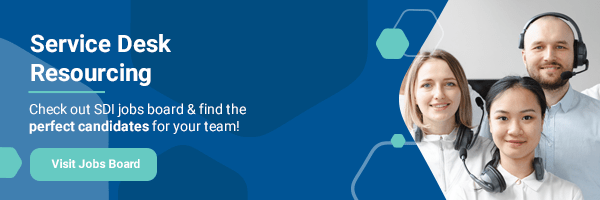
In part 4 of our blog series ’Back to The Future of ITSM’, we spoke with Simone Jo Moore, Industry Thought Leader.
We discussed some exciting things about modern leadership:
- How to build an agile organisation in a sustainable manner and make it more resilient to changes?
- What qualities make a person a great IT leader?
- How is the next generation of IT leaders different from traditional leaders?
- How will organisations need to work in the future?
…and more!
Let’s get started!
Focus on Humanising IT
How to build an agile organisation in a sustainable manner and make it more resilient to changes?
Sustainability in business is not just about surviving the current context but being able to move through and thrive in new and changing contexts.
Resiliency is not something we ‘order online’. It takes experience and a strong sense of self-awareness. While being agile is about the ability to move quickly, flexibly, and decisively, one cannot do so without the mind and culture that helps build resiliency.
Focus on Humanising IT. This includes ensuring we have the capability to respond and adapt quickly to a human outcome necessity. Create multiple networks of competency, and with those connections, you increase the context and flow of communication and support.
Tap into the intelligence across your value streams faster and more deeply. Increased context increases the understanding and ability to make and apply good decisions more quickly.
In your view, what qualities make a person a great IT leader?
“The meeting of two personalities is like the contact of two chemical substances: if there is any reaction, both are transformed”
― C.G. Jung
Being an Empathetic Leader involves you being more authentic and competent in Emotional agility. We talk about being transparent, but that is a passive type of visibility.
Being authentic is not about revealing ‘all’. It’s about becoming visible by actively demonstrating who you are and who you want to become. They inspire people to be motivated, not demand it as an expectation.
“It’s not about being perfect, it’s about being human. This is a journey where a leader shows they are willing to listen and are curious about the passions and values that make a positive difference. “
―Simone Jo Moore
They believe in themselves and in their people, building an emotional culture environment with integrity and empathy. They provide a safe space for us to ‘become’ better than we are. They enable their people to up-skill and re-skill, to continue to grow and develop.
People are not looking to be rescued, they’re looking to feel and be better.
This means being approachable, flexible, intuitive, present, and making others feel cared for. Great leaders provide direction and engage us in the focus of those outcomes.
Help your humans flourish through exceptional experiences.
Leadership Skills for Today and Tomorrow

What do you think about new generations like Gen Z and Millennials as leaders? How are they different from traditional leaders?
The upcoming generations are our future customers, employees, and leaders. They are breaking the traditions of previous generations’ beliefs in what makes a leader. There’s a struggle with the difference in generations and what was acceptable then and what is acceptable now.
They have a more sophisticated filter when it comes to authenticity and like situations that make them think and engage their curiosity far more than accepting the standard learning systems and career progression.
They are always asking:
- What’s the best way right now I can make things happen?
- How quickly can I get where I want to go?
They are constantly innovating, pushing, stretching, flowing, and morphing.
Research shows they have very specific views on engaging with organisations with strong ESG (Environmental, Social & Governance) and DEI (Diversity, Equity, and Inclusivity) values that serve an ongoing and positive future.
They consider how the dynamics of social identity shape their own and others’ experiences. It’s a recalibration to prevent any further damage to our planet and way of life.
“The lines between the professional workplace and personal life have blurred — and that has its own inherent challenges!”
―Simone Jo Moore
Two key components are needed of leaders — belief and expectation.
More specifically, a belief that change is possible and the expectation that the actions of an individual can result in a better future.
The Great Resignation and Quiet Quitting are driving the push for new skills, knowledge, and organisational changes. What’s your view on these trends? How should leaders contribute to a positive work culture to respond to these trends?
First and foremost, we need to break the focus of seeing our people as Human Resources.
The onset of remote work and the disruption, stress and uncertainty created by the last few years has helped to draw attention to, and in many cases prompted companies to rethink, their approach to talent management, in particular, employee health and well-being.
With the complexity and hybrid models, we are seeing wider inequity with the ‘The invisible worker’. This is a challenge and danger in retaining and building our talent.
An important point here is how people are often viewed. We are:
- not human resources – “I’m not something to be consumed and plundered”
- not an asset – “I’m a human being, not a thing”
- not human capital – “you do not own me or get more of me”
It’s called talent management because you are hiring the person. If our talent were in Hollywood, they’d be paid a fortune for how skilful they are at adapting and engaging their emotional agility and creating amazing customer and employee experiences.
We need to be working on our culture as a whole human experience — not separating customer and employee experience. We must recognise the relationship impact and viability they have with each other.
Often underestimated is the impact of empathic leadership in uncertainty and how it can drive productivity. It’s C-Level behaviours that de-stigmatise and normalise areas as strengths rather than weaknesses, like mental health, DEI, and ESG.
Build open environments for honest conversations and deepen empathy throughout the organisation, and don’t confine these areas to a couple of workshops or to buzzwords for corporate marketing. There needs to be substance to the daily experience of both customers and employees.
What the Future Holds
How do you think organisations will need to work in the future? What industry trends should we expect?
Hybrid working at scale is not yet a reality. Sustainable models in the current context are in their infancy. So, to design an anywhere, anytime workplace culture means embracing a different thought pattern on how we enable and visualise the flow of connection.
Create the space for the cognitive and emotional collaboration and thinking that needs to take place for designing a sustainable future. This will minimise risks and help teams embrace uncertainty.
New Intelligence and Renewed Leadership. What comes into your mind when you think about this?
Who you are is important, and even more so is who you are becoming. Renewing and being new is an evolutionary process. It’s about breaking the mould of old thinking patterns!
Do some synaptic pruning in your brain’s programming and forge new thinking pathways.
“Keeping ourselves at the edge of current approaches helps us see the vista of new ones.”
―Simone Jo Moore
We can look back and reflect and then engage ourselves to see the potential of the future. But this also means embracing intelligence from diverse areas. Extrapolations that take our cognitive collaboration wider and deeper and can repurpose what we have and do in new contexts.
It’s also about moving beyond being an individual or organisational leader focus and creating an environment where we can foster emerging leaders.
Concerning innovation with AI, what does “Thinking Outside of the Box” mean to you, your industry, and your organisation?
I don’t see borders, walls, or locks. I see puzzles, blurring boundaries, and things entangled to unravel. Things to be simplified. Technology is not an immutable fact of life, and neither are humans.
Thinking ‘outside the box‘ makes me think of how we view and use the boundaries in place currently. I’m looking for the ones that can be pushed and made elastic while understanding those that are rigid, or if there are curves and so on.
- How do we shift the boundaries?
- What is the liminal space where we’re not sure where some of the understanding exists?
- What kind of scaffolding can we use while we build in this context, and can be viable in future contexts?
Remembering that scaffolding is temporary, be that physical or guidelines, until we have something more solid, and then we take it down and perhaps find a new configuration of scaffolding is needed as we morph.
“We’re always searching for better ways of doing old things and coming up with new things we couldn’t do before.”
―Simone Jo Moore
Not all boxes are square, rectangle or otherwise. Straight lines are not necessarily the way to go, and in fact, linear flow is not always natural!
Let’s get thinking through entanglement! Encouraging new approaches and decomposing and recombining methods is how we untangle and plan for dealing with sticky problems.
Developing Your IT Leaders Matters
Are the leaders of your industry and organisation daring enough to give way to the advancement of AI? Do you consider yourself a daring leader?
Why do we have to ‘give way’? This is old thinking when it comes to the influence of technology on our lives. I believe we are in a new space of rediscovering our humanity.
Not all of our industry leaders have the mindset, competency or support, even if they have the will to be daring. We need to be mindful of providing the training and guidance in exploring the complexity of contexts not inherent in some of those put into leadership roles.
We need the right environment and guidance to reconnect and stay with our core values, to unlock and bring our whole selves to achieving goals.
Yes, be daring. Have the courage to ask the tough questions about how we are designing and using technology. Why? Because the impacts of ethical and emotional AI also impacts not just humanity but closer to our hearts, ourselves and those we care about.
After all, extending our empathy beyond our line of sight only happens when we first show it within our inner circle.
About the author:
Simone Jo Moore is a recognized Top 25 Industry Thought Leader, 2022 Women in DevOps list, and 2021 WomenTech award nominee. Her work involves guiding the digital journey of organisations and individuals in adapting to Humanising IT. Simone is the Editorial Director of ‘The Youth Rise in Power’ and ‘The Era of Humanising IT’ documentaries. Simone takes things beyond technology by combining it with her HR, Organisational Change, and complementary health background.




























